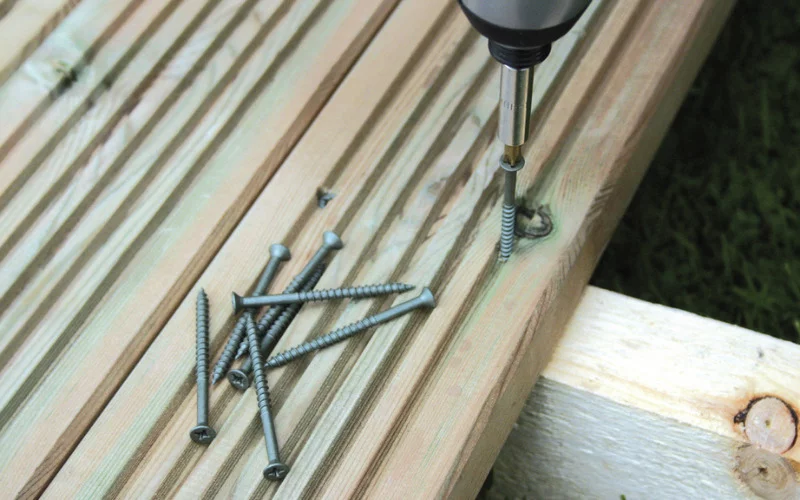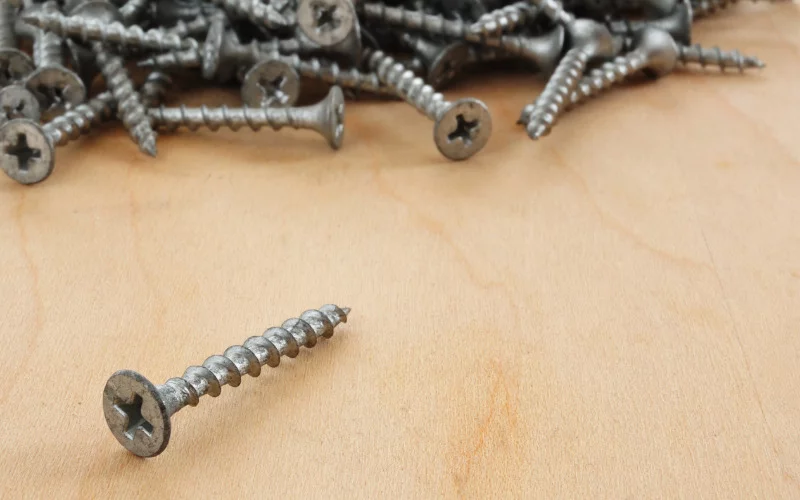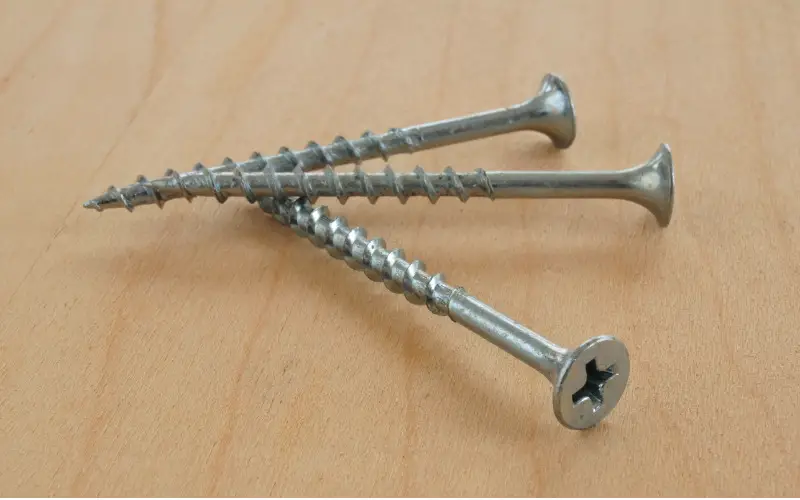Deck screws are distinct from regular wood screws in that they are used to hold down timber or composite deck planks to structural timber or steel beams (joists).
They’ll usually have a parallel rather than a tapered shank. They’ll certainly include a self-drilling and countersink feature, allowing the screw to be installed without predrilling the deck boards.
Other advantages include corrosion protection via a coating or stainless-steel construction and high torque drive fittings such as square, hexagon, and Torx drives.
The screws that hold decking, or “deck flooring,” to a deck’s joist system are designed for countersinking so that the tops are flush or just a hair below the wood’s surface.
This external screw has coarse threads and a smooth top shank, similar to wood screws, and is made to resist rust and corrosion.
Use only ACQ-compatible decking screws when installing pressure-treated wood decking. Installing composite decking requires stainless steel decking screws, according to the manufacturers.
Their length ranges from 1-5/8 to 4 inches, and they are clearly labeled on the packaging as “Decking Screws.” Many decking screws are self-tapping and come in both Philips and star-drive heads. But if you want to know How Much Force Can a Deck Screw Hold read till the end.
What Is The Shear Strength Of A Deck Screw?

Deck screws, unlike bolts and fastened joints, are not meant to withstand shear. A deck screw will often be 2 1/2′′ long and a #7, #8, or #10 size. Now and then, you’ll require a #12 screw.
A few factors, including determining the shear strength of a deck screw.
- Thread type Length
- плед покривало
- Screw top notch
- The screw’s insertion technique and its force (lateral or withdrawal forces).
- The longer the screw, the better it will grip the surfaces linked together.
The longer the screw, the better it will grip the surfaces that will be linked together.
Deck screws, unlike bolts and fastened joints, are not meant to withstand shear. You can even use two screws to support even more weight.
They’ll usually have a parallel rather than a tapered shank. They’ll certainly include a self-drilling and countersink feature, allowing the screw to be installed without predrilling the deck boards.
Other advantages include corrosion protection via a coating or stainless-steel construction and high torque drive fittings such as square, hexagon, and Torx drives.
Deck screws offer a significant benefit over nails and wooden screws in that they eliminate the chance of the material splitting, cracking, or weakening at the attachment site.
The deck screw’s overall basic design makes it the best choice for individuals wishing to build a solid and safe building that is firmly fastened.
If you want your deck screw to perform properly, you also need to consider the thread type. When applied on soft surfaces, coarse threads, for example, will hold strong due to the extra space between each thread.
When attaching hard surfaces, a fine deck screw is preferable. Fine screws have tighter threads that provide more grip, resulting in a compact and robust unit.
How Much Force Can a Deck Screw Hold?
Deck screws, unlike bolts and fastened joints, are not meant to withstand shear. You can even use two screws to support even more weight.
The more the number of screws, the more the force that the screw can hold, and with this combination of screws, you can hold 200 pounds up to 800 even.
Deck construction necessitates a wide range of components. Standard Fasteners, including everything from joist hangers to carriage bolts, lags, Deck Nails, and Decking Screws, account for between 2 to 5% of the overall material cost for a typical deck.
This proportion will rise if you use 18-8 stainless steel hardware, which is less troublesome. Because this is the hardware you’ll see every time you walk out onto the deck surface, it’s critical to choose your deck screws carefully.
Doubling up on a screw in a stud is the simplest technique to increase the amount of weight it can support.
If there’s room for a second or third screw, go ahead and add it. Two screws can support a weight of 160-200 pounds.
Three screws can support a weight of 240-300 pounds. For the greatest results, use a stud finder to locate the center. Because the stud can hold several hundred pounds, you can double up like this.
Use only ACQ-compatible decking screws when installing pressure-treated wood decking.
Installing composite decking requires stainless steel decking screws, according to the manufacturers.
Their length ranges from 1-5/8 to 4 inches, and they are clearly labeled on the packaging as “Decking Screws.” Self-tapping decking screws are available with both Philips and star-drive heads.
Distribution is also beneficial, particularly in keeping the shelves from sagging. Use each stud if the item you’re hanging spans numerous studs.
This more evenly distributes the load and provides you more opportunities to double up.
If you’re using cleats or brackets that require more than one screw to attach to the wall, all the screws are important.
Screws with a square (or Robertson) head, Phillip’s head, or a Torx head are most used on decks, fences, and outside buildings.
Each has advantages over the other in terms of commonly used tools, less wear or stripping, and installation speed.
How Much Weight Can a Decking Screw Hold?
The screws that hold decking, or “deck flooring,” to a deck’s joist system are designed for countersinking so that the tops are flush or just a hair below the wood’s surface.
This external screw has coarse threads and a smooth top shank, similar to wood screws, and is made to resist rust and corrosion.
The following factors determine how much weight a screw can hold:
1. Length of screw
The length of the screw is one of the most critical considerations you’ll have to make. This may have a significant impact on how far it can penetrate the wall.
It won’t obtain a firm grasp on the wall if it doesn’t dig deep enough. As a result, the weight is more likely to draw the screw into place. To avoid this, make sure you purchase a screw that is long enough for the project.
2. Type of thread
You should also consider the sort сковорода купить of thread you wish to employ. There are two types of thread available: coarse thread and fine thread. The best one to utilize will typically be determined by the type of project you’re working on.
Coarser threads have greater space between them. This may make screwing into the materials easier.
Some screws have serrated ends to make the process even easier. These have sharper blades and can cut through thicker materials more quickly.
3. The quality of the screw
You should also consider the quality of the screws you are utilizing. The screw’s strength determines how much weight it can support.
A weaker screw, on the other hand, can bend under pressure and shear off. The steel alloy and how it was tempered are two of the most crucial factors that can affect the screw’s quality.
To ensure that you get a high-quality screw, make sure you buy it from a respected retailer.
You should also think about the screw’s thickness. The thicker the screw, the more weight it can support.
4. The way it’s been inserted
You should also consider how you screwed the screw into the material. This will impact how tightly it can grip the materials and how much weight it can bear before being yanked from the hold.
This is crucial if you intend to hang something indoors. In this position, screwing the items into the drywall is a common mistake.
The drywall can give way without the support of the studs. You can locate the studs with the help of a stud finder.
5. The type of force on the screw
Finally, the amount of force applied to the screw can significantly impact the amount of weight it can support.
There are two types of forces that can be excreted in general. There are two types of forces: lateral and withdrawal forces.
When two materials are moving away from each other, lateral forces are created. You might want to use набір каструль a thicker screw in this scenario. This will ensure that the two materials are securely joined.
What Screws Have the Best Shear Strength?

When applied at a right angle to the fastener’s axis, shear strength is defined as the highest load supported before breakage.
Single shear refers to a load that occurs in only one transverse plane. Double shear is defined as a load applied in two planes that causes the fastener to be cut into three parts.
Deck screws are not designed to withstand shear forces, which are common in framing applications. Plain nails have a lot of shear strength but not much resistance to withdrawal.
The deck screw material you choose must be compatible with the material of your deck board.
Composite decking, for example, requires the use of composite deck screws, which are a superb choice for both strength and appearance.
On the other hand, wood decking requires stainless steel composite or hardware that has been evaluated for ACQ compatibility, a popular softwood lumber chemical treatment.
How Do You Determine a Screw’s Strength?
The strength (tensile, shear bending, etc.) can be determined depending on the standard to which they are constructed. The following should be noted:
- Determine the bolt material’s alloy and heat treatment.
- Determine the material’s кастрюли купить tensile strength.
- Calculate the minor diameter.
Bolt strength is equal to the material strength multiplied by the cross-sectional area.
Structural screws are a new type of fastener on the market. They’re frequently utilized instead of lag screws because they’re considerably easier to work with.
The design of structural screws removes the requirement for pilot hole drilling and lags, resulting in greater convenience. However, the material should be predrilled to prevent damage to the structure’s covering when utilizing metal.
Structural screws are typically stronger than lag screws and provide a more durable material connection.
Because structural screws are driven into the construction material without the assistance of a pilot hole, they are more challenging to design than lag screws.
Mini-drill bits are affixed to the end of some screws, which help clear wood when the screws are drilled in.
The shear resistance is good in structural screws, with a typical maximum permissible shear of 250 to 400 pounds.
Structural screws are manufactured to specified specifications, which are frequently listed for each type of screw.
To boost the strength of structural screws, designers apply various treatments, including heat treating and galvanizing.
Conclusion: How Much Force Can a Deck Screw Hold
Deck screws are weatherproof fasteners that are used to secure decking planks to joints. They are available in carbon steel or stainless steel, both of which offer excellent corrosion resistance.
It’s important to remember that all decking screws have self-sinking and drilling features designed for use in softer woods like pine and other softwoods.
If used in hardwood decking boards, the wood would still need to be predrilled and pre-countersunk because hardwoods are too tough for any fastener to drive straight in.
If you’re working on an outdoor project, deck screws are the way to go. Deck screws can be used to fasten boards, construct framing, and place rails on decks.
The deck screws are known for their ability to survive harsh weather conditions and carry a greater load than standard wood screws, making them ideal for more sturdy timber structures and projects.
You May Also Like:
- What is The Shear Strength of a Deck Screw
- How To String a Wind Chime (Step-by-Step Guide)
- Factors to Consider When Buying a Snowblower for Gravel Driveway
We trust this article helped you determine How Much Force Can a Deck Screw Hold. You may also want to discover How To Find Amethyst in Your Backyard.
Thanks for taking the time to read our article, and we hope you find it helpful. Would you mind leaving a comment below if you have any suggestions?
Kindly reach out to people by sharing this post on social media.
If you liked this article, then please follow купити мультитул us on Facebook, Instagram, and Pinterest.
Cheers!
www.backyardcaring.com
How Much Force Can a Deck Screw Hold? (How to Determine a Screw’s Strength?)

